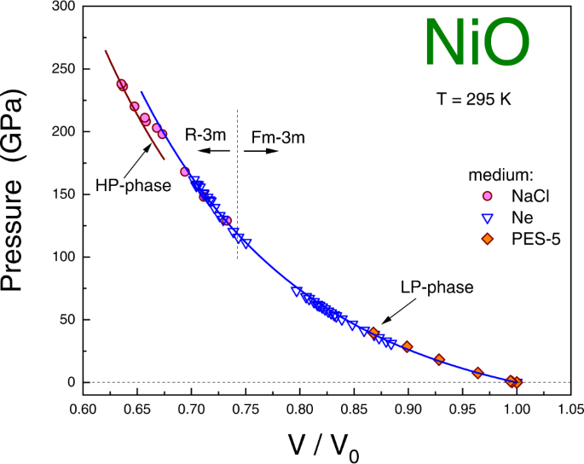
The insulator-metal transition (IMT) in compressed nickel monoxide (NiO) is extremely important for understanding the physics of strongly correlated electronic systems.The concomitant collapse of spin and magnetism in the material has generated multiple, and often conflicting, theoretical and experimental efforts. Therefore, building on their previous findings of a transition to the metallic stateat 240 ± 10 GPa, a group co-led by HPSTAR's Dr. Viktor Struzhkin report an accompanying iso-structural transition in NiO at 225 ± 15 GPa in their latest work “The First-order structural transition in NiO at high pressure” published in Communications Physics. Their findings aim to resolve experimental controversies and confirm some recent theoretical models.
In pioneering studies by Mott and co-workers, NiO was considered a typical example of a “Mott” insulator with a wide d-d energy gap Eg, which occurs due to strong on-site Coulomb electron repulsion between Ni 3d electrons.At the same time, Mott predicted a possible IMT in compressed NiO. The first suggestions of metallic high-pressure phase of NiO were made by Boer, Verwey, Mott, and Peierls. However, numerous theoretical studies provide contradictory predictions regarding the pressure range and nature of the IMT in NiO. Early theoretical LDA and GGA calculations by Cohen et al.predicted that band-broadening effects are responsible for a magnetic collapse in simple oxides FeO, MnO, and CoO; and a nearly second-order phase transition accompanied by magnetic collapse at 230 GPa was predicted in NiO. However, Feng et al.showed that the more ‘sophisticated’ B3LYP density functional predicts a transition at significantly higher pressure than the GGA functional. More recent predictions using ab-initio (LSDA + U) calculations indicated a transition above 300 GPa,but the most recent calculation using DMFT method predicted a transition pressure at 429 GPa in NiO. Thus, the theoretical controversy over the pressure of the transition has remained unresolved.
To elucidate the possible structural changes at the NiOtransition and reconcile the controversy in the existing literature, the group used multimegabar diamond anvil cell techniques to structurally study NiO in the widest possible pressure range of (0–240 GPa) to date. Starting from ~110 GPa, they observed a significant trigonal distortion of the initially NaCl-type crystal structure. At higher pressures, a structural transition with a volume drop of ~2.7% was detected experimentally in the region of the insulator-metal transition. Finally, they observeda first-order structural transition accompanying the insulator-metal transition in NiO at 225 ± 15 GPa.

Caption: The experimental pressure-volume dependence in NiO at hydrostatic and quasi-hydrostatic conditions up to 238 GPa.
The spatial scales of the HP and LP phase regions in NiO have not been identified yet, but the dimensions of the separated phases must be quite large according to the relatively narrow X-ray diffraction peaks observed. To understand the effects of stress on the phase separation, future studies should address the whole pressure interval of the coexistence of the HP and the LP phases in NiO in more hydrostatic pressure media to clarify the hysteresis effects of the reverse transition. Given the simplicity of the material and its fundamental importance to our understanding of strongly correlated electronic systems, these findings should stimulate further experimental and theoretical studies of NiO, a prototype Mott insulator.
NiO中绝缘 - 金属转变以及伴随的自旋和磁性的瓦解是强关联电子研究中的重要课题,其促进了多种理论和实验方面的研究,旨在理解强关联电子体系的复杂物理性质。高科中心的Strushkin研究员带领的研究团队的最新研究在高压下发现了NiO中的等结构相变,该相变同时伴随着向金属态的转变。这些发现解决了一些实验上关于相变的争议,并且证实了一些最新的理论模型。鉴于材料的简单性及其对理解强关联电子体系的重要性,该研究将促进进一步对来莫特绝缘体原型方面的实验和理论研究。该研究成果发表于Communications Physics。